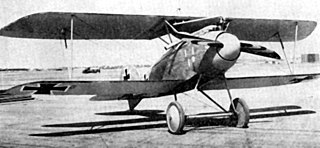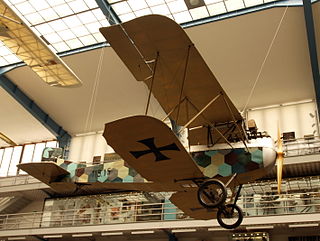
The Albatros D.III was a biplane fighter aircraft used by the Imperial German Army Air Service (Luftstreitkräfte) during World War I. A modified licence model was built by Oeffag for the Austro-Hungarian Air Service (Luftfahrtruppen). The D.III was flown by many top German aces, including Wilhelm Frankl, Erich Löwenhardt, Manfred von Richthofen, Karl Emil Schäfer, Ernst Udet, and Kurt Wolff, and Austro-Hungarian ones, like Godwin von Brumowski. It was the preeminent fighter during the period of German aerial dominance known as "Bloody April" 1917.

The Aviatik B.I is a German two-seat reconnaissance biplane designed and built by the Automobil und Aviatik AG company, who until then had produced copies of French designs.

The Austro-Daimler 6 was a series of Austrian six-cylinder water-cooled inline SOHC aero engines first produced in 1910 by the Austro-Daimler company.

In 1914 Otto Hieronimus manufactured the six-cylinder Hiero E, also known as the Hiero 6 engine which was derived from earlier 4-cylinder engines. The Hiero engine like the Austro-Daimler powered many of Austria's World War I aircraft. Hiero aircraft engines were designed by Otto Hieronimus, a famous Austrian auto racer of the early 1900s. His initial designs were liquid-cooled inline engines built by the Laurin & Klement Automobile Works of Austria.

The Hansa-Brandenburg C.I, also known as Type LDD, was a 2-seater armed single-engine reconnaissance biplane designed by Ernst Heinkel, who worked at that time for the parent company in Germany. The C.I had similarities with the earlier B.I, including inward-sloping interplane bracing struts. Like other early-war Austro-Hungarian reconnaissance aircraft, such as C-types of Lloyd or Lohner, the Type LDD had a communal cockpit for its crew.

The Lohner L was a reconnaissance flying boat produced in Austria-Hungary during World War I. It was a two-bay biplane of typical configuration for the flying boats of the day, with its pusher engine mounted on struts in the interplane gap. The pilot and observer sat side by side in an open cockpit, and both the upper and lower sets of wings featured sweepback.
The Aviatik (Berg) D.II, the prototypes of which were known as Aviatik 30.22 and Aviatik 30.38, was an Austro-Hungarian fighter plane prototype towards the end of the First World War.
UFAG, was an aircraft manufacturer formed by Freiherr Karl von Škoda in Budapest during World War I. It built aircraft of their own design as well as underlicence to Lohner and Hansa-Brandenburg. Aircraft produced by UFAG were allocated 60 series serial numbers for experimental and prototype aircraft and 61 to 69 for production aircraft.

The Knoller C.II was a reconnaissance aircraft built in Austria-Hungary during World War I for use by the Austro-Hungarian army. It was a conventional biplane design with staggered wings, and seated the pilot and observer in tandem in an open cockpit. Like Knoller's preceding C.I design, the upper wing was swept back, but not as far as it had been on the earlier aircraft. The structure was wooden throughout, with the wings skinned in fabric and the fuselage in plywood. The interplane struts were made of steel and arranged in a warren truss configuration.

The Lloyd C.II and its derivatives, the C.III and C.IV were reconnaissance aircraft produced in Austria-Hungary during the First World War. They were based on the Lloyd company's pre-war C.I design, and like it, were conventional biplanes with swept-back wings.

The Lohner B.II was a military reconnaissance aircraft produced in Austria-Hungary during World War I. It was a development of the pre-war B.I design, incorporating changes requested by the Austro-Hungarian army, but inheriting its predecessor's basic design, including its characteristic swept-back wings.

The unarmed Lohner B.VII and its armed derivative the C.I were military reconnaissance aircraft produced in Austria-Hungary during World War I. They were the ultimate developments in a family of aircraft that had begun with the B.I prior to the outbreak of war, and were the first members of that family that proved suitable for front-line service during the conflict. Like their predecessors, the B.VII and C.I were conventional biplanes with characteristic swept-back wings.
The Aviatik C.I, the prototypes of which were known as Aviatik 30.14, Aviatik 30.15 and Aviatik 30.16, was an Austro-Hungarian 2-seat reconnaissance aircraft produced from 1917.(Note: the is not part of the designation, but used to disambiguate from the German-built Aviatik aircraft with the same designation.)

The Phönix C.I, given serial numbers in the Phönix 121 range, was an Austro-Hungarian First World War reconnaissance and general-purpose Biplane built by Phönix and Lloyd.
The Union G.I was a bomber aircraft designed and built in Germany from 1914.

Eduardo Barrón was a Spanish aeronautical engineer and military pilot who led the design department at Talleres Loring from 1923 to 1930.

The Lohner Type AA were a series of prototype fighters built during World War I. The program would eventually be cancelled due to inherent instability concerns of the design.
The Lohner 10.15, also known as Schichtpreis Eindecker Type 1914, Lohner A 23, Gnome-Etrich and by its c/n AD 489, was a monoplane racing aircraft designed and built in late 1913 for the 1914 Schichtpreis race. Requisitioned at the start of World War One by the Luftschifferabteilung (LA), the sole 10.15 remained active as a trainer until at least November 1917.

The UFAG C.I was a military reconnaissance aircraft produced in the Austro-Hungarian Empire during World War I, by the Ungarische Flugzeugfabrik Abteil Gesellschaft (UFAG). It was introduced in April 1918, and was widely used on the Italian Front in the final months of World War I.

The Rapp Rp III was a six-cylinder, SOHC valvetrain liquid-cooled inline aircraft engine built by Rapp Motorenwerke. The Rapp six-cylinder engines were developed from a previous Rapp four-cylinder design, which originated from Karl Rapps earlier 90 hp four-cylinder that he had designed at the Flugwerk Deutschland GmbH for the 1912 Kaiserpreis aircraft engine contest.















